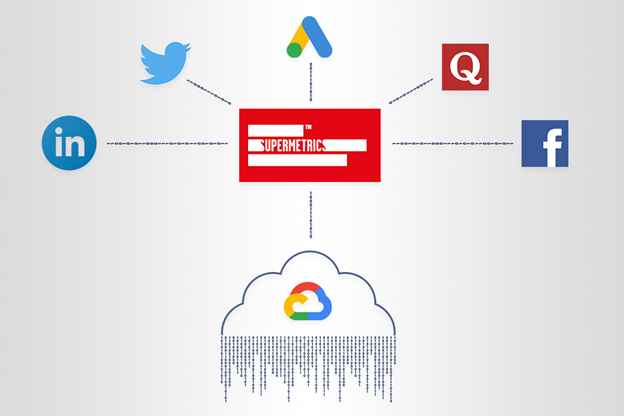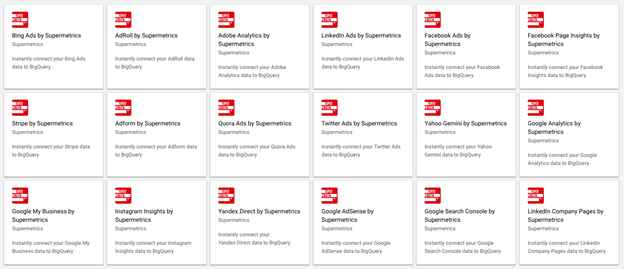Google Cloud Platform gets native Supermetrics-BigQuery integration, empowering multichannel marketers

On the heels of the many big developments coming out of the Google Cloud Next event in San Francisco, marketing metrics platform Supermetrics has announced the release of Supermetrics for BigQuery on the Google Cloud Platform (GCP) marketplace.
The new solution enables marketers to leverage Supermetrics’s data connection capabilities for campaign analysis, while using Google’s BigQuery data warehousing service.
BigQuery is an emerging leader in the data warehousing space. As a cloud-based service, it provides users with an accessible and scalable platform to store large volumes of data. Multichannel marketers stand to benefit from Supermetrics’s integration with BigQuery as they can easily set up their own highly usable marketing data warehouses with just a few clicks.
Combining data across all customer touchpoints from marketing platforms to CRM and offline activities will get easier and give marketers a whole new level of understanding of their customer’s behavior, leading to significantly better business intelligence insights,” asserts Supermetrics CEO Mikael Thuneberg.

Supermetrics CEO Mikael Thuneberg deep in thought
“This will increase the amount and complexity of the data organizations work with, and therefore, solutions like Supermetrics for BigQuery will become absolutely necessary, as they enable efficient and frictionless reporting and analysis of large data sets.”
Using this setup, marketers will be able to readily consolidate the information gathered from the various marketing platforms and social media channels they use. The integration’s code-free interface makes it more convenient for them to query, export and analyze data, even if they have no experience formulating database queries.
The need to go multichannel
Marketers’ need for big data capabilities has become more apparent in recent years. Considering that customers and prospects now interact with businesses through both physical and digital means, companies have to establish multiple channels through which they can engage with people for acquisition and retention purposes.
Retail, for example, is increasingly shifting to digital. Online sales during 2018’s Black Friday grew 23.6 percent from the previous year, totaling $6.22 billion. Reports have also indicated that online sales may have led to fewer customers buying from physical stores. Putting up an ecommerce presence has become a logical and necessary move for most merchants. But to be successful, businesses need to have a good understanding of online consumer behaviors.

The catalog of available Supermetrics connectors for BigQuery
As such, marketers must experiment a great deal, which calls for collecting and drawing insights out of relevant data in order to craft campaigns that lead to better engagement and conversion. “For me, any business decision comes down the return on investment,” Thuneberg says of the metrics that matter most.
“CAC (customer acquisition cost) and LTV (customer lifetime value) are unquestionably among the marketing metrics we pay the most attention to ourselves at Supermetrics. I bet many marketers would agree to this in theory but probably find the analysis hard in practice. Things get harder and more complex because of multi-touch conversion funnels, the limitations of attribution technologies, and most importantly the lack of powerful, flexible and affordable analytics tools.”
Marketing data warehousing
Fortunately, technology is making it easier for marketers to collect and process larger sets of information from a wide variety of sources. Analytics trackers can be embedded in digital channels like the company website and their various social media accounts in order to log all user inputs and actions. Smart devices, trackers, and connected point-of-sale systems can also be used in brick and mortar facilities to gather customer data.
Marketers now also use various next-generation digital tools for lead generation, email marketing, inbound and outbound marketing, and sentiment analysis – all of which can generate hundreds of thousands of entries.
Through these data gathering efforts, companies often find themselves accumulating massive volumes of data. In addition, it is also common for information to remain siloed within the various devices and applications, since the data originates from “walled garden” sources. This fragmentation of data sources makes it a challenge for marketers to correlate information for richer insights.
Marketers must make a conscious effort to consolidate data and store it in a robust and reliable facility such as a data warehouse.
Analytics integration
Solutions like Supermetrics for BigQuery provide the means for marketers to effectively handle big marketing data. It can pull together data from different sources including Google Analytics and Ads, Amazon, Facebook, YouTube, and Twitter and push them into a centralized storage like BigQuery.
“Supermetrics was started with a simple mission – to help marketers move their data from wherever it is to whichever tools they want to use the data in,” says Thuneberg. “On one side, we integrate with the most popular PPC, SEO, social, web analytics and other marketing platforms as data sources. On the other side, we’ve connected to several data destinations, including Google Sheets, Google Data Studio, and Microsoft Excel. Expanding our supported data destinations to data warehouses like BigQuery is a natural next step in freeing data for marketers across the globe.
“BigQuery is just the beginning of our expansion into data warehouse solutions – definitely not the end. We’re looking to cover other data warehouse solutions like Amazon in the next six to 18 months.”
In addition, Supermetrics enables users to process and analyze marketing data. It has powerful reporting and visualization functions that allows marketers to use standardized field labels, to merge fields and to run custom formulas during the import process, so as to present query results in dashboards for easy understanding on an automated basis.
As a self-service analytics platform, Supermetrics can be used even by staff who aren’t familiar with coding to perform analyses and generate insights. This reduces the expertise overhead for business in their big data projects.
Big data benefits
Among the key goals of adopting big data for business is to generate critical insights that can be used to guide actions and business decisions. By investing in the ability to gather, store, and process multichannel marketing data, business effectively increase their ability to generate such insights.
Through a better understanding of their marketing audiences and customers, marketers can also optimize their spending by allocating resources towards the channels, creatives and targeting parameters that the data indicates as delivering the most advantageous engagement. Better engagement typically leads to a stronger bottom line through better sales and increased retention.
Companies can take advantage of these new solutions and technologies to help improve their ability to handle multichannel marketing with agility.

